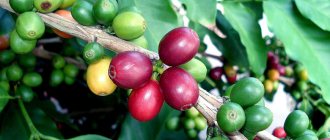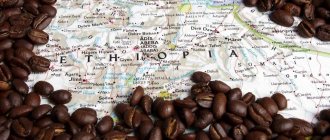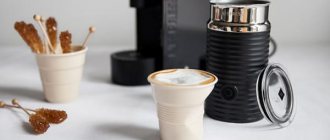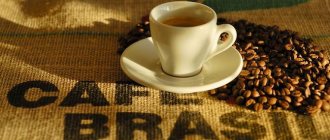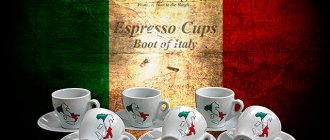What is coffee
Coffee is a tree-like plant of the Rubiaceae family. There are about 90 species of coffee trees on the planet. The two main ones that are most widespread are Arabica Coffee (Arabica) and Canefora Coffee (Robusta). About 98% of the total number of coffee trees belong to them. The share of other species accounts for only 2% of plantings.
The coffee tree produces large berries that turn bright red when ripe. After harvesting the fruits, the grains are removed from them, dried, fried and ground, and then a decoction or infusion is prepared. Using this technology, for several hundred years humanity has been obtaining a drink called coffee , named after the plant that provides raw materials for it. So the question of what coffee is cannot be answered unambiguously.
The term "coffee" has 4 meanings
Coffee is a tree-like plant with bright red berries, the beans of which are used to make a coffee drink.
Coffee is the grain of the coffee berry.
Coffee is a drink that is made from ground coffee berry beans by decoction or infusion.
Coffee is instant drinks made from extracts of natural coffee beans.
By carrying out active selection on the basis of two main types of coffee trees, man has obtained many new varieties. Their number is difficult to calculate even for specialists. There are hundreds of single varieties, the grains for which are obtained from one type of tree grown in one area. There are even more mixtures. They use grains of different varieties from different countries. Every company that sells coffee strives to create its own blends.
Over hundreds of years of coffee history, people have come up with many ways to prepare an aromatic drink. About three hundred devices for brewing it have been invented.
All this - both types of plants, and varieties of grains, and the finished drink obtained according to any of the recipes - is called in one succinct word “coffee”.
Beneficial properties of coffee
Coffee invigorates
This is perhaps the most famous property of coffee.
This is explained by the fact that caffeine is a psychostimulant. When we drink coffee, caffeine enters the bloodstream and travels with it to the brain, where it blocks the neurotransmitter adenosine. Adenosine is involved in energy transfer, suppresses alertness and stimulates sleep. The concentration of adenosine in the body increases with every hour you are awake, causing drowsiness. When adenosine is blocked, the concentration of other neurotransmitters such as norepinephrine and dopamine increases. This gives an invigorating effect.
Many studies confirm that coffee improves memory, mood, reaction speed, attention and cognitive function. So coffee invigorates and makes us smarter.
Coffee improves the body's performance
When caffeine stimulates the nervous system, it sends signals to other parts of the body. Fat cells receive a signal to break down fat deposits. Those who have recently started drinking coffee burn fat most effectively. According to research Metabolic effects of caffeine in humans: lipid oxidation or futile cycling? , caffeine burns up to 29% of fat in thin people and up to 10% in those who are obese. When fats enter the bloodstream and are converted into free fatty acids, the body can use them as a source of energy.
In addition, caffeine increases the level of adrenaline in the blood, which prepares the body for intense physical activity. So before your next trip to the gym, try drinking a cup of black coffee.
Coffee relieves muscle pain after exercise
Based on the results of the study Caffeine Attenuates Delayed-Onset Muscle Pain and Force Loss Following Eccentric Exercise. , two cups of brewed coffee after a workout relieves muscle pain. During this experiment, participants drank coffee after performing eccentric muscle exercises. After an hour, they were asked to rate the intensity of pain on a scale from 0 to 100. It turned out that caffeinated coffee significantly reduced sensitivity to pain.
Coffee helps fight depression
Caffeine increases the production of dopamine, a neurotransmitter responsible for movement, memory and thinking. Dopamine is also associated with the feeling of pleasure. This is why coffee helps fight depression.
According to a study conducted at Harvard University Coffee, Caffeine, and Risk of Depression Among Women. , in women who drink coffee, the risk of depression is reduced by 20%. Another study showed A Prospective Study of Coffee Drinking and Suicide in Women. that those who drink coffee are 53% less likely to commit suicide. Participants in both studies drank four cups of coffee per day.
Coffee is good for liver health
Some believe that coffee can protect against cirrhosis. A study conducted by Singaporean scientists confirmed Coffee, alcohol and other beverages in relation to cirrhosis mortality: the Singapore Chinese Health Study. that drinking two or more cups of coffee per day can reduce the risk of developing cirrhosis by about 66%.
Other researchers have found that drinking coffee may also reduce the risk of liver cancer. Coffee Reduces Risk for Hepatocellular Carcinoma: An Updated Meta-analysis. . And decaffeinated coffee reduces the level of liver enzymes in the blood. Inverse associations of total and decaffeinated coffee with liver enzyme levels in NHANES 1999–2010. .
Coffee may prevent gallstone formation
Gallstones are hard formations in the gallbladder. They appear due to an incorrect diet (too much cholesterol), problems with the gallbladder (it does not empty completely) and due to certain diseases, such as cirrhosis.
Caffeine helps prevent the formation of gallstones. This was confirmed by a study in which scientists observed coffee consumption and the formation of gallstones in 46,000 men for 10 years. A prospective study of coffee consumption and the risk of symptomatic gallstone disease in men. . Another study that included women found the same results. Coffee intake is associated with a lower risk of symptomatic gallstone disease in women. .
Coffee may reduce the risk of type 2 diabetes
An analysis of 18 studies (total number of participants - 457,922 people) confirmed that each cup of coffee drunk reduces the risk of developing diabetes by approximately 7% Coffee, Decaffeinated Coffee, and Tea Consumption in Relation to Incident Type 2 Diabetes Mellitus. .
Drinking coffee affects sex hormone-binding globulin (SHBG) Associations of sex hormone-binding globulin and testosterone with diabetes among men and women. . This protein controls the activity of the sex hormones testosterone and estrogen, which play a role in the development of type 2 diabetes.
The study authors noted that there is an inverse relationship between coffee consumption and the risk of diabetes. By increasing plasma SHBG levels, coffee appears to prevent the development of diabetes.
Coffee reduces risk of Alzheimer's disease
Alzheimer's disease appears after age 65. It is the most common neurodegenerative disease in the world. Patients gradually lose memory, thinking skills and the ability to perform simple tasks.
unsplash.com
There is no cure for this disease yet. However, there are many preventive measures. These include a healthy diet, regular physical and mental exercise, and drinking coffee. Many studies confirm Does caffeine intake protect from Alzheimer's disease? that coffee reduces the risk of developing Alzheimer's disease by up to 65%.
Coffee reduces the risk of Parkinson's disease
The second most common neurodegenerative disease is Parkinson's disease. It develops when neurons in the brain that produce dopamine die. Drinking coffee reduces the risk by about 30–60% Coffee and tea consumption and the risk of Parkinson's disease. . A possible reason is the positive effect of caffeine on neurotransmitters responsible for the production of dopamine.
In addition, coffee may also be beneficial for those who already suffer from Parkinson's disease. According to scientists from McGill University Caffeine for treatment of Parkinson disease. , caffeine helps such patients control movements.
Coffee protects against heart failure
Moderate coffee consumption has been shown to protect against heart failure. Habitual Coffee Consumption and Risk of Heart Failure: A Dose–Response Meta-Analysis. . The key word is "moderate". This usually means two cups a day.
Coffee is the best source of antioxidants
Coffee, both decaffeinated and decaffeinated, contains approximately the same amount of antioxidants. Moreover, it is more than in fruits and vegetables combined (in a typical Western diet). Antioxidants are substances that prevent oxidation and fight free radicals in the body. For example, they reduce the risk of oral cancer Coffee, Tea, and Fatal Oral/Pharyngeal Cancer in a Large Prospective US Cohort. . Decaffeinated coffee also has a protective effect, but tea does not have it at all.
Coffee protects against retinal damage
One of the most powerful antioxidants is chlorogenic acid. Researchers at Cornell University have found that this coffee compound reduces retinal cell death caused by hypoxia (oxygen deprivation) or oxidative stress (cell damage due to oxidation) Chlorogenic Acid and Coffee Prevent Hypoxia-Induced Retinal Degeneration. . The effects of chlorogenic acid were also tested in mice with damaged optic nerves. The results were the same.
Coffee reduces the risk of colon cancer
The researchers followed 489,706 participants and found that among those who drank 4-5 cups of coffee, the risk of colorectal cancer was 15% lower. Caffeinated and decaffeinated coffee and tea intakes and risk of colorectal cancer in a large prospective study. .
Coffee reduces the risk of skin cancer
Basalioma is one of the most common forms of skin cancer. Although it is usually not fatal, it does cause permanent physical damage to the skin.
A study conducted by American scientists proved that caffeine consumption reduces the risk of skin cancer Increased Caffeine Intake Is Associated with Reduced Risk of Basal Cell Carcinoma of the Skin. . The lowest risk was observed in women who drank three cups of coffee per day.
Another study found that coffee may help prevent melanoma. Prospective study of coffee drinking and risk of melanoma in the United States. .
Coffee protects against tooth decay
At the Institute of Dental Sciences in India, scientists conducted a study and collected data from all patients who drank coffee. At the same time, they took into account the frequency of consumption, brand of coffee, the presence and absence of additives (milk, sugar), as well as the diet and other habits of the patients.
As a result, it turned out that those who drink about three cups of black coffee a day have the least dental problems. Can coffee prevent cavities? . But sweeteners, cream and milk completely deprive coffee of its antibacterial properties.
Coffee can strengthen DNA
DNA strands sometimes break. Double-strand breaks occur when byproducts of cellular metabolism cause damage to DNA and block its replication. This will lead to cell death if the DNA is not restored. And if it is restored incorrectly, some sections of DNA may be rearranged. Such rearrangements are commonly found in cancer cells.
Scientists observed healthy men for four weeks, some of whom drank black coffee, and some of whom drank water. Initially, the two groups experienced the same number of spontaneous DNA breaks. Then, among those who drank only water, an increase in the number of breaks was noticed, and among those who drank coffee, a decrease. Consumption of a dark roast coffee decreases the level of spontaneous DNA strand breaks: a randomized controlled trial. . The difference was 27%.
Coffee reduces the risk of gout
Gout is a common form of arthritis that usually affects men and most often affects the joints of the big toes. In especially severe cases, the joints become permanently deformed.
Researchers followed 45,000 men for 12 years and took into account what drinks they drank (coffee, decaffeinated coffee, tea). Among the participants, 757 people suffered from gout.
As a result, it turned out that increasing coffee consumption reduced the risk of developing gout Coffee consumption and risk of incident gout in men. . Decaffeinated coffee was less effective in this case, and tea had no effect at all.
Coffee is rich in nutrients
unsplash.com
Coffee contains more than just caffeine and antioxidants. Most of the nutrients that coffee beans are rich in remain in the drink and are absorbed by the body.
One cup of coffee contains:
- Vitamin B2: 11% of the recommended daily value.
- Vitamin B5: 6% of the recommended daily value.
- Manganese and potassium: 3% of the recommended daily value.
- Vitamin B3 and magnesium: 2% of the recommended daily value.
This amount may seem insignificant, but this is only enough for one cup, and many people drink 3-4 cups a day.
In addition, coffee beans are rich in fiber - healthy dietary fiber. The researchers tested different methods of preparing coffee (espresso, filter, instant). The results confirmed that brewed coffee contains more soluble dietary fiber than any other Dietary Fiber in Brewed Coffee beverage. .
But what coffee contains a little is calories (if you drink it without milk and sugar).
Coffee grinders
What could be more pleasant than the smell of freshly ground coffee beans? Even the gloomiest morning will not be able to resist it. In order to make good coffee, it is important to choose a decent coffee grinder, reliable and functional, and preferably not too expensive! We study different types of coffee grinders - rotary and burr, automatic and manual. Our focus is mainly on coffee grinders for the home, but sometimes we also look at professional coffee grinders. What is better - to give preference to equipment from well-known brands: Bosh, Macap, Mazzer, or to prefer devices from the economy segment - Vitek or Scarlett? We analyze the advantages and disadvantages of coffee grinders, current prices and models to make it easier for our readers to choose. Whenever possible, we interview real technology users and ask them to share their experiences, so we welcome your feedback in this section.
The meaning of the word Coffee according to Ushakov’s dictionary:
COFFEE uncl., m. coffee (loose) avg. (from Arabic kahva - wine, from the name of the country in Africa - Kaffa). Beans of a tropical plant - the coffee tree. Coffee beans. Ground coffee. Roasted coffee. || A drink made from these grains, roasted and ground. To drink coffee. Mocha . Black coffee. (without cream). Warsaw style coffee Then he drank his coffee . Pushkin. || A surrogate for this product. Malt coffee. Barley coffee. Coffee made from wine berries.
Turks for coffee
A cezve for coffee is a traditional utensil for preparing the drink. Kofella is a site about coffee and coffee culture, so Turks take up a whole section for making coffee, because over several hundred years humanity has accumulated vast experience in making and using this utensil.
Latest articles in the section
Aug 17, 2016 Porcelain coffee pot July 22, 2016 Spoon for coffee July 19, 2016 Which coffee pot is better
We carefully collect everything about coffee cezves: how to choose and where to buy, how much a cezve costs and which one is better, how to clean a copper cezve and what are the features of an electric cezve. Copper and silver, ceramic and porcelain, glass and even crystal Turks became the heroes of our articles. We tell you how to brew delicious coffee in a Turk, help you find a cezve as a gift, buy a Turk for different types of stoves, and even choose a spoon for a Turk.
The cezve has been used by people for about five centuries, and during this time it has practically not changed in appearance or functionality. In our modern kitchens, we prepare coffee in the same way as our distant ancestors. The cezve preserves the traditions of generations, we find it fascinating and even exciting. Therefore, we are happy to collect and tell our visitors everything about Turks for coffee.
Coffee varieties
The taste of a drink in a cup is determined by many factors, but the first of them is the type of grain. Want to know exactly which coffee is worth trying? Go to the “Coffee varieties” section. Here we talk about the countries of the world coffee belt and the taste characteristics of coffee from different regions of the world. What are the differences between Arabica and Robusta and which coffee is the most expensive? Why is the Malabar Monsoon so prized by some and why is Galapagos San Cristobal sold in such limited quantities? What is the specialty of Jamaica Blue Mountain coffee and the specialty of Tanzania Peaberry? What is the secret of the unprecedented popularity of the Geisha variety? In the section you will already find descriptions of classic bean varieties, stories about new products and trends of the coffee season.
Latest articles in the section
Sep 05, 2019Japanese coffeeSep 05, 2019Maragogype coffeeSep 05, 2019Bourbon coffee
In Dahl's dictionary
inclined coffee plant, its beans and a drink made from them. Coffee arabica. Swedish coffee, plant. Astragalus boeticu. Rye coffee. chicory, carrot, etc. burned from these substances, instead of coffee, coffee, related to coffee. - infusion, - smell, - color, dark brown, dark brown, the color of boiled coffee. Coffee house, coffee shop an establishment that sells brewed coffee and snacks. A coffee pot, a container of various types, for brewing coffee. | Hunter drinking coffee. -nitsa a tin or other container with a lid for storing burnt and sometimes ground coffee. | Lover of this drink. | A fortune teller using coffee grounds. Make coffee, drink coffee. Coffee shop and. the court rank of caretaker for coffee, tea, chocolate, etc. who, at court, goes for hot food.
Alternative methods of brewing coffee
Purover
Another well-known method of brewing aromatic coffee is pour over . During the cooking process, water heats up and passes through the ground grains when they are in a paper funnel filter. Here you can even adjust the strength by increasing the dose of powder. This method also goes by other names. Hario or V60 is the same name as a pour-over brewing device.
French press
Invented in 1929 , the French press method is widely considered the best and easiest way to make excellent, smooth coffee. It has more superior flavors than any other method. In a French press, ground coffee is brewed in hot water and strained. Fragranced essential oils, caffeine and antioxidants are better dispersed and retained, leaving the purest scents.
Clever and Bonavita
A kind of funnel-shaped cup is used here. At its core, this method resembles a pour-over. But the Clever and Bonavita is made of porcelain, it does not add any extraneous tastes.
Aeropress
A relatively new manufacturer, Aerobie Frisbee (Alan Adler), created and launched AeroPress in 2005 . The AeroPress is plastic and comes in 3 parts. The filter sits in the coffee basket at the bottom of the brew chamber when hot water is added to it. To extract the drink, press the piston. This creates air pressure so that the already brewed air passes through the filter and enters the cup.
Siphon
Fashionable and luxurious coffee maker. By brewing coffee in a siphon , you can impress your friends. This method was invented in the pre-war years in Germany.
The ground grains are added to the upper container. Steam pressure forces boiling water through them. Once the heat is removed, the brewed coffee is also forced back through the filter into the bottom of the vessel. Popular brands that produce siphons:
- Hario;
- Yama;
- Bodum.
Chemex
For acidic varieties, the Chemex cooking method will help to reveal their aroma. At the same time, the sweetness is emphasized and the excessive bitterness of the drink is smoothed out.
Three faces of coffee
Coffee can come in three forms: as an aromatic drink, as a medicine, and as a poison. There is nothing unnatural in this, at first glance, unexpected combination, since coffee affects each organism differently. After a cup of coffee, most people feel cheerfulness, a surge of energy, increased efficiency and improved mood, while some, on the contrary, feel uneasy from just the smell of coffee. For such people, even one cup of drink can cause insomnia, headaches, high blood pressure, and anxiety. In addition, some people fall asleep without problems after drinking coffee, while others cannot sleep a wink.
What is "body"?
Body is one of the key characteristics of coffee consumed by professionals. This list also includes acidity, sweetness, and aftertaste. To put it very simply, the body is about the tactile sensations in the mouth that you experience when sipping the drink you are tasting. Feelings of density or lightness, richness, richness of taste.
Often a gradation from light to heavy is applied to the coffee body. To understand it, imagine that you first hold skim milk in your mouth, then whole milk, and then cream. If we apply coffee terminology to dairy products, it turns out that low-fat milk has a light body, whole milk has a heavier body, and cream has a very heavy, dense body.
Density, heaviness or, conversely, lightness refer to the intensity of tactile sensations. The coffee body has one more characteristic - the quality when you evaluate your sensations as pleasant or not very pleasant. A high-quality body can be called silky, creamy, smooth, creamy. Poor quality – dusty, dry, astringent.
Definition of the word "Coffee" according to TSB:
Coffee (English coffee, Dutch koffie, from Arabic kahwa) 1) the same as Coffee tree. 2) The seeds of the coffee tree (coffee beans, or grains), used to prepare the tonic drink known by the same name, and to obtain caffeine from them. China is an important object of world trade. World production of K. beans in 1971 amounted to about 4.9 million tons. of which over 65% are in Latin American countries, mainly in Brazil and Colombia, as well as in Mexico, El Salvador, Costa Rica, Guatemala, etc. about 27% in African countries, mainly in the Ivory Coast, Ethiopia, Angola , Uganda, etc.. the rest is in Asia, mainly in Indonesia, India and the Philippines. China's main supplier-exporter is Brazil (over 1/3 of China's world exports). Colombia, Ivory Coast, Uganda, Angola, Guatemala, and Mexico supply a significant amount of K. to the world market. The main consumers of carbon are the USA (1/3 of world imports of carbon), Germany, France, Italy, the Netherlands, and Sweden. Raw or roasted K. grains, ground and soluble K. are sold. To give K. grains collected from a tree a marketable appearance, they are freed from pulp by fermentation, then dried at 50-60°C and polished. Caffeine is obtained from raw beans. Drink K. is prepared from roasted (at 180-200°C for 25-30 minutes) and ground grains. When beans are roasted, sugar caramelizes and substances are formed that give the drink a brown color, pleasant taste and aroma. There are many varieties of K. They are called by the place of production or by the name of the port through which they are exported. The Yemenite (“mocha”) K., produced in small quantities, is considered the best. High quality Brazilian (“Santos”, etc.) and Colombian (for example, “Mame”) varieties. Depending on the variety of K., its chemical composition varies somewhat. The average content of nitrogenous substances in it is 13-14%, caffeine 0.65-2.7, sugar 2-3, fat 12-15, fiber over 20, minerals 3-4%. Due to the significant caffeine content, K. has a stimulating and tonic effect on the central nervous system. 1 teaspoon of ground caffeine, usually used to prepare a glass of drink, contains a single therapeutic dose of caffeine (0.07-0.1 g). The drink from K. also stimulates gastric secretion. For people with increased excitability of the nervous system, suffering from palpitations, peptic ulcers, hypertension, insomnia, a drink made from natural K. is not recommended. "TO." also called commercially available coffee substitutes made from a wide variety of plant materials (for example, roasted barley, acorns, etc.) that do not contain caffeine. Many coffee substitutes also add natural K.
Coffee as medicine
The extraordinary properties of coffee are remembered in the ancient legend about Sheikh Omar, a doctor and priest who lived as a hermit in a cave. According to legend, the sheikh treated the sick who came to him with this miraculous decoction of the fruits of the coffee tree.
Even before 1000 AD. The Arab physician and alchemist Rhazes in his writings described the medicinal properties of the drink “binchum” - i.e. coffee. At that time in the East it was believed that coffee accelerates thought, cheers the heart, treats eye diseases, and is an excellent remedy for gout, dropsy and scurvy. "Kawa" in Arabic means "to be strong", "active", "to strengthen".
Despite the fact that many famous legends and stories about coffee say that this drink was used in ancient times to treat various diseases, at present there is no exact data whether coffee was originally used as a drink or as a medicine. However, the wonderful properties of coffee fruits were noticed by scientists, doctors and chefs, thanks to whom we now enjoy this wonderful drink.
How to choose and prepare coffee correctly
Making coffee can be divided into several stages. The beans are first harvested and blended to create a unique flavor and balance the result. The grains are then roasted and ground. The degree of roasting and coarseness of grinding depend on the type of machine you choose to prepare the drink in. A variety of devices are used for brewing: a cezve or Turk for oriental coffee, a filtered coffee maker or dripper, a French press, a geyser-type coffee maker or moka, and an espresso machine.
When choosing coffee, pay attention to its aroma and appearance of the grain.
- The first one should be bright, rich and appetizing
- the second - identical in size, color and roasting, not damaged along the way.
- No more than a year should pass from the moment of collection and roasting.
- The packaging must not be torn or dirty.
- And most importantly, good coffee will not be cheap. It's better not to skimp on the taste of the grains.
Black coffee is drunk from small porcelain cups with cold water. Many lovers, however, recommend doing the opposite: first a sip of water, then a drink. Drinks with milk are served in tea cups, cappuccino - in 150 ml cups. If you are served oriental coffee, do not stir it so as not to raise the grounds from the bottom. The same applies to Turkish coffee.


